Choose a budget gaming desktop if you prioritize maximum performance per dollar, upgrade potential, and don’t need portability. You’ll get more powerful components for under $1,000, better cooling, quieter operation, and easy future upgrades. Opt for a gaming laptop if mobility matters most to you, despite paying premium prices ($1,700+) for equivalent performance and facing limited upgrade options. Consider hidden costs like peripherals for desktops and higher laptop repair expenses when making your decision.
Performance Per Dollar: Which Offers Better Value
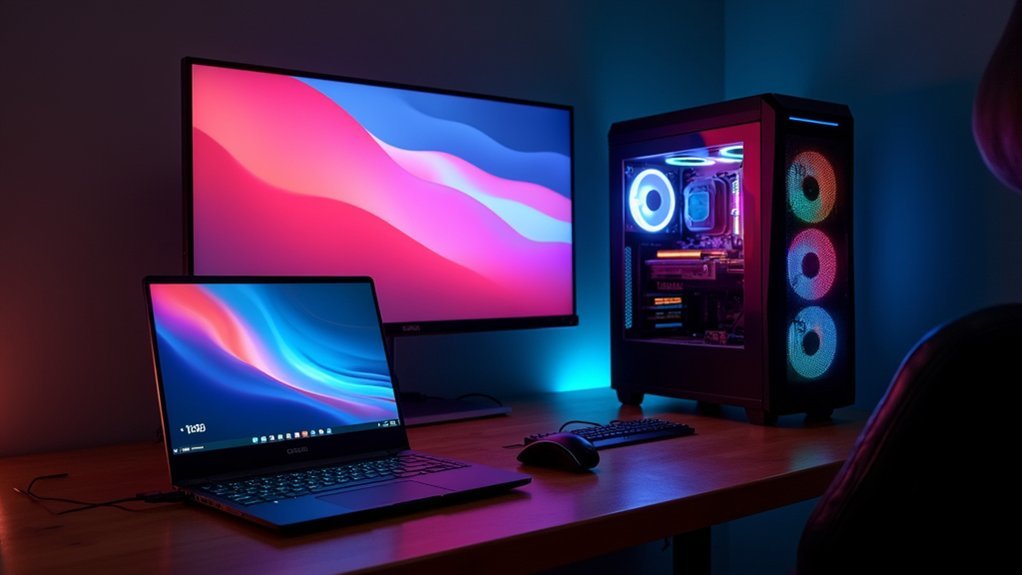
When you’re weighing performance against price, desktops consistently deliver more bang for your buck than gaming laptops. Equivalent desktop setups typically cost less while offering more powerful components in the same price range.
You’ll find budget gaming desktops under $1,000, while high-performance gaming laptops range from $1,700 to $4,299. This price difference means significant savings for budget-conscious buyers.
Desktops also provide superior long-term value through upgradability. You can enhance performance over time without replacing your entire system.
Upgrade components individually rather than buying an entirely new system, maximizing your investment over several years.
Gaming laptops may require additional costs for peripherals and screens, further reducing their value proposition. For casual gamers playing at lower resolutions, budget-friendly desktops offer adequate performance without the premium price tag of high-end gaming laptops.
Portability Vs Power: Understanding the Trade-Offs
When you’re choosing between a budget gaming laptop and desktop, you’ll face a fundamental trade-off between mobility and raw performance.
Gaming laptops let you game anywhere – whether you’re traveling, studying in different locations, or simply don’t have space for a full desktop setup.
However, desktops deliver considerably more gaming power for your money, thanks to better cooling systems and the ability to house more powerful components without the size constraints of portable designs.
Laptop Mobility Benefits
The freedom to game anywhere represents one of the most compelling advantages of choosing a laptop over a desktop setup. You’ll find that gaming laptops run efficiently while weighing under 2.5kg, making them perfect for travel or cramped spaces like airplane seats and coffee shops. This portability means you’re not tied to a single location for your gaming sessions.
| Feature | Gaming Laptop | Gaming Desktop |
|---|---|---|
| Weight | Under 2.5kg | 15-30kg+ |
| Setup Time | Instant | 30+ minutes |
| Space Required | Minimal | Full desk setup |
| Travel Friendly | Yes | No |
While gaming laptops run with built-in screens, keyboards, and trackpads for immediate use, you’ll sacrifice some gaming performance compared to a gaming desktop due to thermal constraints and compact design limitations.
Desktop Performance Advantages
Although gaming laptops offer unmatched portability, desktop systems deliver substantially more raw power for your gaming investment.
Desktop performance advantages become evident when you’re running demanding games at high settings and resolutions.
- Superior components: Desktop GPUs like the RTX 3080 feature more cores and memory bandwidth than mobile versions.
- Enhanced thermal solutions: Better airflow and cooling systems prevent overheating during extended gaming sessions.
- Quieter operation: Larger cases accommodate bigger fans that run at lower speeds.
- Higher frame rates: More powerful hardware delivers smoother gameplay at maximum settings.
- Future-proof upgradability: Easy component swapping extends your system’s lifespan.
While gaming laptops excel in portability, they can’t match desktop power.
Desktops remain the cost-effective choice for serious gamers prioritizing performance over mobility.
Upgrade Potential and Future-Proofing Your Investment
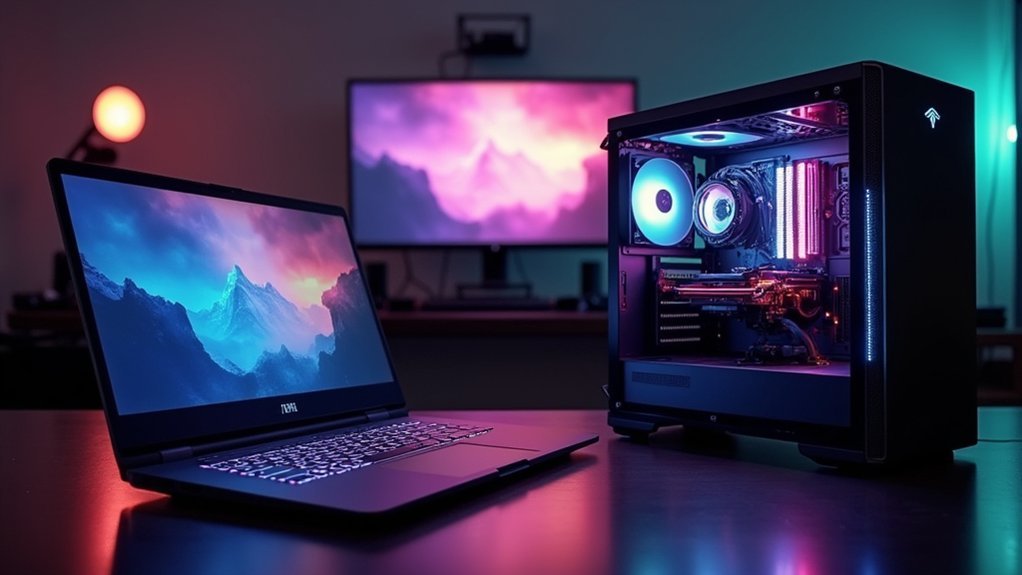
Since gaming technology evolves rapidly, you’ll want to contemplate how well your chosen system can adapt to future demands.
Gaming desktops excel in upgrade potential, offering accessible internal components that let you swap out GPUs, CPUs, and other parts easily. This future-proofing capability means you can enhance performance incrementally without replacing your entire system.
Gaming laptops severely limit your upgrade options. Most key components like CPUs and GPUs are soldered to the motherboard, restricting you to upgrading only RAM and storage.
While laptops offer portability, they typically become outdated faster due to their fixed configurations.
Desktops prove more cost-effective long-term through their modular design. You’ll maintain system relevance by tailoring upgrades to evolving gaming technologies, making desktops the superior choice for serious gamers seeking adaptable solutions.
Hidden Costs: Beyond the Initial Purchase Price
When you’re comparing budget gaming options, the sticker price doesn’t tell the whole story.
You’ll need to factor in essential peripherals like external monitors, mechanical keyboards, and gaming mice that can quickly add hundreds to your total investment.
Beyond these immediate costs, you’re also looking at long-term upgrade expenses that differ dramatically between laptops and desktops.
Essential Peripheral Costs
The sticker price on your gaming desktop tells only part of the story.
When comparing gaming laptop vs desktop options for budget gaming, you’ll need to factor in essential peripheral costs that can dramatically increase your total cost of ownership.
Unlike laptops with integrated components, desktops require separate purchases that add up quickly.
Essential peripheral costs include:
- Monitor – Quality gaming displays range from $150-$300
- Keyboard and mouse – Gaming peripherals cost $50-$150 combined
- Audio equipment – Speakers or headsets add $30-$100
- Power supply protection – Surge protectors cost $20-$50
- Cables and accessories – Various connections require $20-$40
These additions can push your desktop setup $200-$500 beyond the base price, while gaming laptops offer immediate usability out of the box.
Long-term Upgrade Expenses
While your initial purchase represents just the beginning of your gaming investment, understanding long-term upgrade expenses reveals the true cost difference between laptops and desktops.
Gaming laptops severely limit your upgrade options since CPUs and GPUs are typically soldered to the motherboard. You’ll likely need to replace the entire unit to maintain competitive performance, creating substantial long-term expenses.
Gaming desktops offer modular designs that let you swap components individually. You can upgrade your GPU, CPU, or RAM without replacing everything, keeping your system current with minimal investment.
Though desktops require upfront peripheral costs, their upgradeability delivers superior long-term value. Desktop repair costs are also lower, while laptops may incur hidden expenses as you struggle to maintain performance over time.
Thermal Management and Cooling Considerations
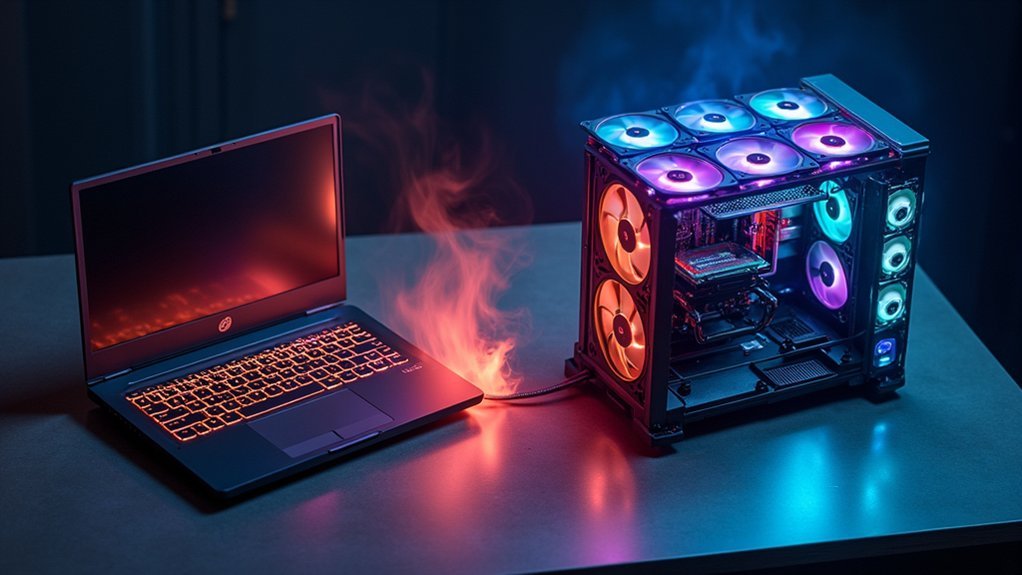
As you dive deeper into intensive gaming sessions, thermal management becomes a critical factor that’ll markedly impact your system’s performance and longevity.
Desktops maintain a clear advantage with superior airflow and larger cooling solutions, while gaming laptops struggle with compact designs that generate excessive heat.
Desktop towers excel at heat dissipation through spacious internal layouts, while gaming laptops face thermal constraints from cramped component arrangements.
Here’s how thermal performance differs between platforms:
- Desktops offer expandable cooling options including liquid cooling systems
- Gaming laptops rely on small, fast-spinning fans that create noise and heat buildup
- Desktop airflow design prevents thermal throttling during demanding sessions
- Laptop cooling limitations often require performance compromises under heavy loads
- Upgrading desktop cooling systems extends hardware lifespan considerably
You’ll find desktops provide better performance sustainability during extended gaming, whereas laptops may throttle performance to manage temperatures, affecting your gaming experience.
Display Options and Gaming Experience Quality
Beyond thermal considerations, your choice between laptop and desktop gaming fundamentally shapes the visual quality and immersive potential of your gaming sessions.
Gaming laptops offer impressive built-in displays, featuring mini-LED screens with up to 1000 nits brightness and technologies like Nvidia’s DLSS 3 for enhanced frame rates.
However, desktops provide superior display options, supporting 4K and high-refresh-rate monitors that deliver exceptional gaming experience quality.
You’ll find desktop graphics cards typically outperform laptop variants, enabling better graphical fidelity at higher settings.
While laptops offer convenience with integrated displays, desktops allow multiple monitor setups for expansive screen real estate.
Your budget gaming decision ultimately depends on whether you prioritize portability with decent visuals or maximum display flexibility with superior performance.
Battery Life Vs Always-On Gaming Power
You’ll face a fundamental trade-off between mobility and power consistency when choosing between laptops and desktops for gaming.
Gaming laptops offer around 7 hours of battery life for basic tasks, but demanding games will drain that power quickly and force you to plug in for peak performance.
Desktops eliminate battery concerns entirely with their always-on power supply, letting you game continuously without worrying about power management strategies or performance drops.
Laptop Battery Gaming Sessions
When you’re considering a gaming laptop, battery life becomes a critical factor that directly impacts your gaming experience.
Gaming laptops face significant power demands that severely limit unplugged gaming sessions. You’ll find that laptop battery gaming sessions typically last only 1-2 hours under heavy gaming loads, making extended portable gaming challenging.
- Most gaming laptops consume 200-300 watts during intensive gameplay, draining batteries rapidly.
- Non-gaming tasks extend battery life to 5-7 hours, but gaming performance requires constant power.
- High-end models like the Razer Blade 16 prioritize performance over battery efficiency.
- Technologies like Nvidia’s DLSS can help manage power consumption while maintaining quality.
- Plugging in remains essential for ideal gaming performance and sustained sessions.
You’ll need to balance portability expectations with the reality of frequent charging requirements.
Desktop Continuous Power Supply
Unlike laptops that struggle with battery limitations, gaming desktops operate with a continuous power supply that eliminates performance compromises entirely. Your desktop experience remains consistently powerful since you’re always plugged into external electricity, delivering maximum gaming performance without worrying about battery drain.
| Gaming Desktops | Gaming Laptops |
|---|---|
| Always-on power | 7-hour battery limits |
| 500+ watts available | 200-300 watts max |
| Zero performance drops | Compromised on battery |
| Unlimited gaming sessions | Must plug in frequently |
| Maximum sustained performance | Performance varies by power |
While gaming laptops offer mobility, they can’t match the unwavering performance that continuous power supply provides. You’ll never experience sudden shutdowns or reduced frame rates during intense gaming sessions, making desktops ideal for competitive gaming where consistent performance matters most.
Power Management Strategies
Power management becomes a critical consideration when weighing desktop reliability against laptop flexibility.
Gaming laptops offer approximately 7 hours of battery life for standard tasks, but you’ll need to plug in during gaming sessions due to their 200-300 watt power demands.
Desktops consume over 500 watts but provide consistent always-on gaming without battery concerns.
Effective power management strategies include:
- Using power-saving settings to extend gaming laptops’ battery longevity
- Employing cooling stands to manage heat generation and reduce fan noise
- Plugging in laptops during intensive gaming for peak performance
- Leveraging desktops’ continuous power supply for uninterrupted gaming sessions
- Balancing portability needs against consistent power availability
Your choice depends on whether you prioritize desktop reliability or laptop mobility for your gaming setup.
Storage Solutions: Speed and Capacity Comparisons
How does storage performance impact your gaming experience when choosing between laptops and desktops?
Storage solutions greatly affect loading times and overall game performance. Gaming laptops typically include SSDs with speeds around 3,000 MB/s, but you’re usually limited to 1TB or less capacity.
Gaming laptops deliver solid SSD performance at 3,000 MB/s but typically max out at 1TB storage capacity.
Desktops offer superior flexibility – you can install high-performance SSDs reaching 7,000 MB/s alongside multiple HDDs for extensive storage exceeding several terabytes.
While laptops provide convenient all-in-one storage, desktops allow easy upgrades and expansion for growing game libraries.
You’ll find desktops offer more connectivity options for external drives and additional storage devices.
Though both platforms support external storage, desktops provide greater adaptability for future needs, making them ideal if you plan extensive gaming collections.
Peripheral Requirements and Additional Equipment
Beyond storage considerations, you’ll need to account for the peripheral requirements that greatly impact your total gaming setup cost.
Gaming laptops arrive ready-to-use with built-in displays, keyboards, and touchpads, eliminating immediate accessory purchases.
Desktop PCs require separate monitors, keyboards, and mice before you can start gaming.
While desktop PCs offer extensive connectivity options through multiple ports for enhanced customization, gaming laptops provide instant portability without extra accessories.
Consider these peripheral factors:
- Initial laptop costs include all necessary components for immediate gaming
- Desktop setups require additional monitor, keyboard, and mouse purchases
- Desktop connectivity options allow easier peripheral upgrades over time
- Laptops eliminate cable management and setup complexity
- Long-term desktop flexibility may offset higher initial peripheral investments
Budget-conscious buyers should calculate total ownership costs, including future upgrade potential.
Space Requirements and Setup Flexibility
| Feature | Gaming Laptop | Desktop |
|---|---|---|
| Space Needed | Minimal desk space | Dedicated setup area |
| Portability | Under 2.5kg, highly portable | Heavy, stationary |
| Setup flexibility | Instant use, easy storage | Fixed position, extensive setup |
Laptops clearly win for cramped spaces and frequent relocations.
Noise Levels During Gaming Sessions
During intense gaming sessions, you’ll notice a stark difference in noise levels between laptops and desktops. Gaming laptops typically produce 40-50 decibels under load due to their compact design requiring faster-spinning cooling fans.
Gaming laptops run louder than desktops during intense sessions, hitting 40-50 decibels due to compact cooling requirements.
Conversely, gaming desktops operate quieter at 30-40 decibels by utilizing larger fans and advanced cooling solutions.
Key noise considerations include:
- Gaming laptops generate more audible fan sounds during demanding tasks
- Desktops achieve quieter operation through larger, slower-spinning cooling fans
- High-performance laptops like the Razer Blade 16 manage noise effectively during lighter tasks
- Desktop configurations offer superior noise control for prolonged gaming
- Your noise tolerance should influence your choice between portability and acoustic comfort
If you’re sensitive to noise or game in quiet environments, desktops provide a more peaceful experience.
Repair Costs and Warranty Coverage
When your gaming system inevitably needs repairs, you’ll face considerably different costs and coverage options between laptops and desktops.
Gaming laptops typically cost more to repair due to their compact design, which makes component replacement challenging and often requires specialized service. You can’t easily swap parts yourself like you’d with desktops.
Desktops offer significant advantages in repair costs thanks to their modular design. You’ll find component access much easier, allowing you to replace or upgrade parts without professional help. This saves money and reduces downtime.
Warranty coverage also differs substantially. Gaming laptops may exclude damages from overclocking or modifications, limiting your customization options.
Meanwhile, many pre-built desktops include extensive warranties covering various issues, providing better long-term protection against hardware failures.
Best Budget Gaming Scenarios for Each Option
While both laptops and desktops can deliver solid gaming experiences under $1,000, your specific gaming lifestyle determines which option provides better value.
Gaming laptops excel when you:
- Travel frequently and need portable gaming solutions
- Have limited desk space or live in small apartments
- Prefer all-in-one convenience without cable management
- Game casually at moderate settings and resolutions
- Value immediate setup without additional peripheral costs
Gaming desktops shine when you:
- Prioritize maximum performance per dollar spent
- Plan extended competitive gaming sessions requiring superior cooling
- Want significant upgrade potential for future improvements
- Have dedicated gaming space with room for tower setup
- Seek long-term value through component replacements
Consider desktops for serious gaming where performance matters most, while laptops suit mobile lifestyles prioritizing convenience over raw specifications.
Frequently Asked Questions
Is It Better to Buy a Desktop or Laptop for Gaming?
Choose a desktop if you’re prioritizing performance and budget-effectiveness for home gaming. Pick a laptop if you need portability and convenience for gaming on-the-go, accepting slightly reduced performance.
Is $1000 Dollars a Lot for a Gaming PC?
$1000 isn’t a lot for a gaming PC—it’s actually a solid entry-level budget. You’ll get decent performance for modern games at medium-high settings, plus better upgrade potential than laptops.
Can a Gaming Laptop Be Used as a Desktop?
Yes, you can use a gaming laptop as a desktop by connecting external monitors, keyboards, and mice. You’ll get desktop-like performance while keeping it plugged in for peak power.
What Is the Downside of a Gaming Laptop?
You’ll face limited upgrade options, higher costs for equivalent performance, excessive heat and noise, poor battery life while gaming, and weaker specs compared to desktops at similar prices.
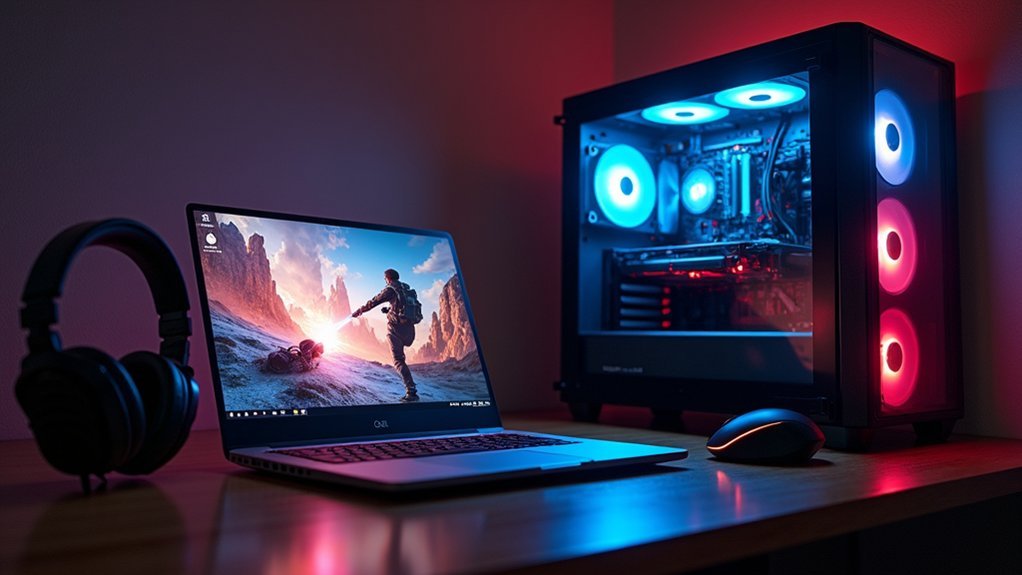
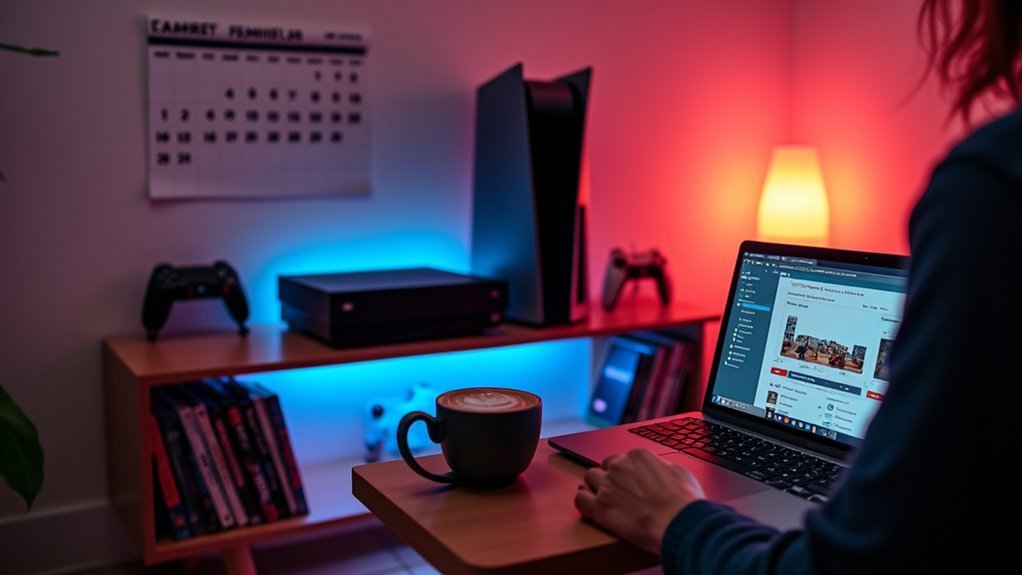


Leave a Reply